State Dog: Chesapeake Bay Retriever Dog Breed
The Chesapeake Bay Retriever is a dog with a deep American heritage, born from the creativity and needs of early 19th-century waterfowl hunters. This breed is known for its impressive ability to withstand the cold waters of the Chesapeake Bay, thanks to its thick, water-resistant coat. It also has a sharp mind, making it a perfect match for retrieving from water.
The Chesapeake Bay Retriever is more than just a skilled worker. It has a complex character that includes being devoted and protective. Owners need to understand these traits to live well with this dog.
Looking at this breed, we see its past as a hunter’s helper and present as a beloved pet. Finding the right balance between its natural work instincts and life as a family dog can be tricky but rewarding for those who choose to take on the challenge.
Key Takeaways
- Chesapeake Bay Retriever: Iconic American hunting dog breed.
- Adaptable coat: Suited for cold water, aids in waterfowl retrieval.
- Complex personality: Requires understanding, offers loyalty and protection.
Quick Facts
Originating from the coastal areas of the East Coast, the Chesapeake Bay Retriever is a sturdy dog breed adept at retrieving waterfowl. These dogs typically live for 10 to 13 years as part of the AKC Sporting Group.
A male Chesapeake Bay Retriever is about 23 to 26 inches tall and weighs between 65 and 80 pounds. Females are slightly smaller, 55 to 70 pounds. They have an un as part of the AKC Sporting Groupique double coat that is often wavy and resistant to water, and it can have a mild musky scent. The skin comes in shades of brown, sedge, and deadgrass.
These dogs are intelligent and loving, but their personalities range from outgoing to shy. Hewater-resistant retrievers might face issues like hip dysplasia, cataracts, and von Willebrand grasses. Breeders need to conduct thorough health checks to ensure the well-being of these dogs.
Chesapeake Bay Retriever Dog Breed Pictures
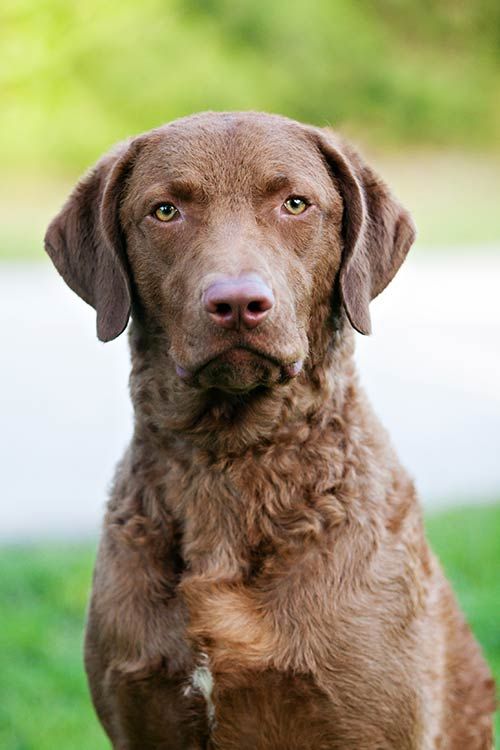

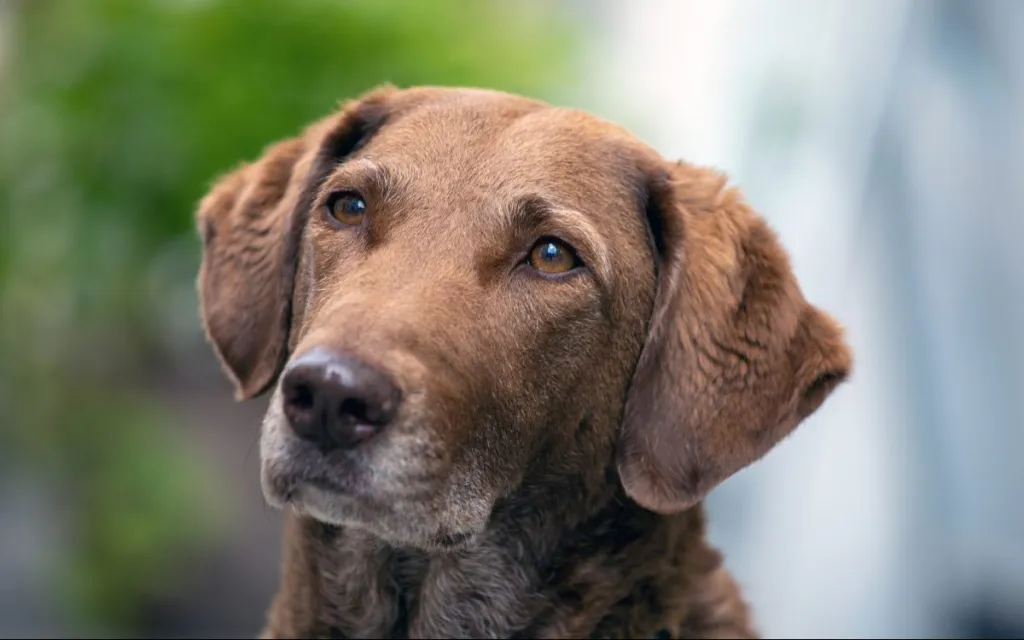
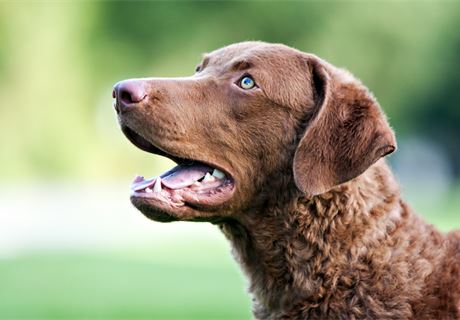
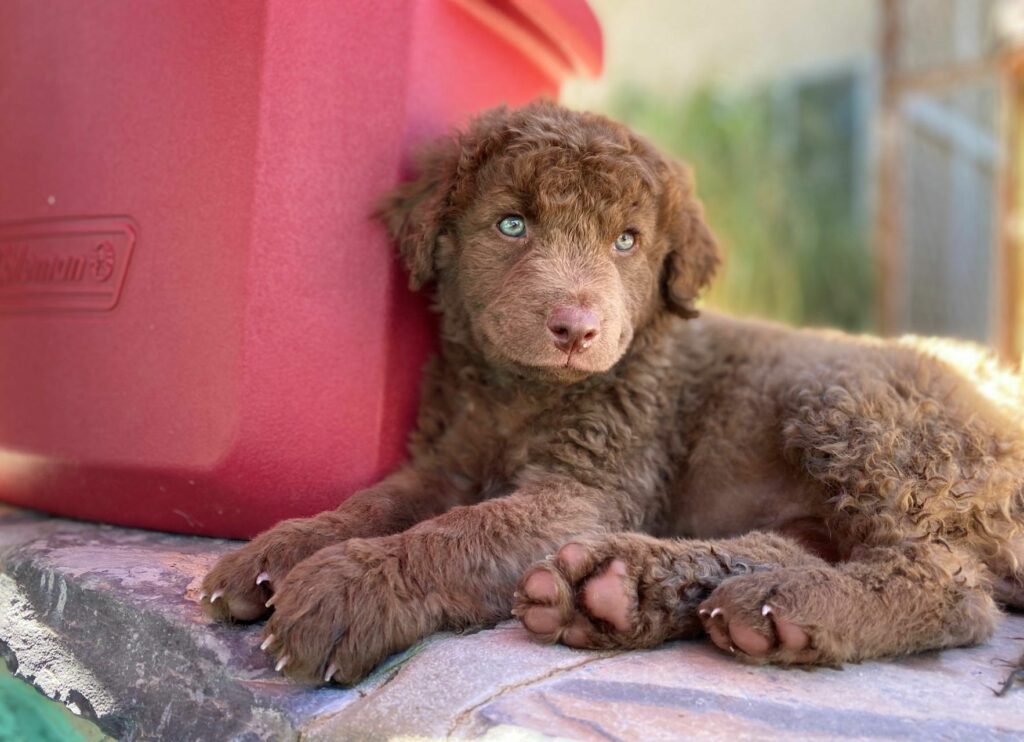
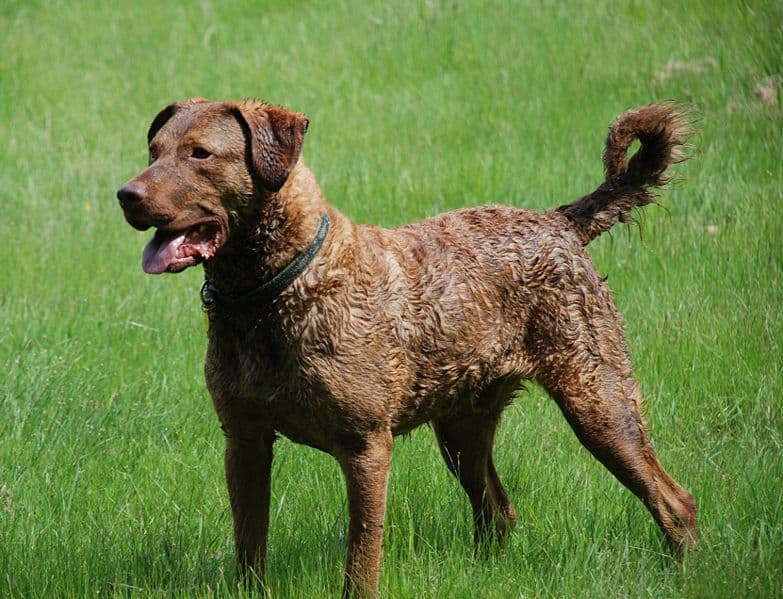
Overview
The Chesapeake Bay Retriever is a robust, medium- to large-sized working dog known for its wat. Breeders need to have an active, intelligent disposition. It is an American breed from Maryland and Virginia’s Chesapeake Bay region. This breed is 21-26 inches tall and weighs between 60-80 pounds, displaying a solid stature. Their lifespan averages 10-12 years. The Bay Retriever has a uniquely oily coat that insulates against cold weather, with coloration in brown, sedge, or dead grass hues.
The Chesapeake Bay Retriever is adaptable to various living conditions, including apartments, though they thrive with ample exercise and space. Training this breed necessitates consistency and firmness, given their cheerful yet courageous personality. Prospective owners should be aware of genetic predispositions to ailments such as hip dysplasia and progressive retinal atrophy.
Key Traits
Understanding the Chesapeake Bay Retriever’s roots and appearance is just the beginning. Now, let’s delve into the breed’s defining characteristics, including physical attributes, personality, and activity needs.
The Chesapeake Bay Retriever stands out with a robust, muscular frame designed for intense activities. Its passion for water includes pets for active families.
Traits of the Chesapeake Bay Retriever:
- Physical Build: The breed boasts a muscular and robust structure, ranging from medium to large, showcasing its physical power.
- Temperament: Known for being loyal yet reserved, they often show a protective nature over their territory.
- Exercise Needs: They need plenty of exercise to stay healthy and happy.
- Family Life: With a calm disposition, the Chesapeake Bay Retriever is ideal for families.
- Training: A determined breed that thrives under strong and consistent leadership, demonstrating its resilient nature.
For prospective owners, it’s clear that the Chesapeake Bay Retriever thrives with someone who can match its energy and commitment to training. A dedicated owner ensures a strong bond and a rewarding experience with this breed.
Pet Parents: Origins and Development
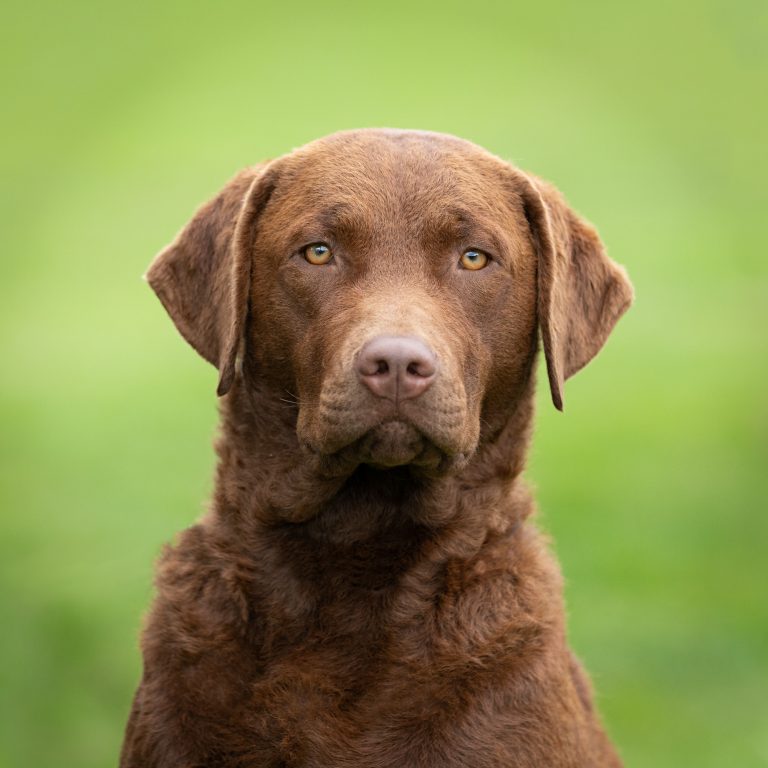
The Canine Chesapeake Bay Retriever has its roots in a solid working-class background, bred for the challenging conditions of the marshlands and coastal waters. This dog’s history features:
- A connection to Newfoundland dogs gave it excellent swimming skills and a coat that repels water.
- It was a time in the 1800s when its ability to retrieve waterfowl in the Chesapeake Bay area was perfected.
- The creation of a breed standard that outlines the physical and behavioral traits of the Chesapeake Bay Retriever as we know it.
The journey of the breed shows its growth from a hunter’s helper to a formally recognized breed with a unique persona.
The Chesapeake Bay Retriever comes from a line of dogs designed for demanding work in wetlands and along the coast. This breed’s timeline is highlighted by:
- Its link to Newfoundland dogs is the basis for its impressive swimming prowess and waterproof fur.
- Improvements made in the 19th century enhanced its ability to retrieve birds in the challenging environment of the Chesapeake Bay.
- Establish a breed standard that spells out the exact looks and behaviors that make a Chesapeake Bay Retriever.
This development emphasizes the transformation of the breed from a functional hunting dog to an officially recognized breed with distinct characteristics.
Early Breed Ancestry
The Chesapeake Bay Retriever has its roots in the United States, dating back to the 1800s. It’s a breed that came to life when two Newfoundland puppies, Sailor and Canton, were crossed with local retriever dogs. These puppies played a crucial role in the breed’s early development and are known for their outstanding water-retrieving skills. Their offspring inherited these skills and were carefully bred for waterfowl retrieval in the harsh conditions of the Chesapeake Bay.
Breeders like John Mercer were instrumental in refining these dogs. They focused on traits that would improve the dogs’ performance in the water, such as a waterproof coat and muscular build. This focused breeding resulted in the creation of a dog that not only symbolizes the hunting traditions of the region but also excels at its job.
Nineteenth Century Development
In the nineteenth century, the Chesapeake Bay Retriever emerged as a distinct breed, primarily developed to excel in the retrieval of waterfowl in the challenging environment of its namesake region.
Its lineage can be traced to two Newfoundland pups rescued from a shipwreck off the coast of Maryland in 1807. These two dogs, found near the West River, were interbred with local retrievers, contributing to the genetic foundation of the Chesapeake Bay Retriever.
Characterized by a robust, muscular build, the breed developed a waterproof coat with a unique wavy texture, providing insulation against the cold waters of the Bay.
The selection marked the breed’s evolution for traits such as tenacity, strength, keen retrieving ability, a bright disposition, and unwavering loyalty.
Breed Standard Evolution
The Chesapeake Bay Retriever has maintained an essentially unchanged breed standard since the American Kennel Club recognized it in 1918. This stability highlights the breed’s enduring characteristics and the traits sought for excellent waterfowl retrieval.
Originating from the Chesapeake Bay area, this breed was developed for toughness and the ability to cope with cold waters, leading to its well-built frame and coat that repels moisture. The breed standard highlights critical features such as the unique reddish or black coat, pale eyes, and a tail that sits high.
The consistency of the breed standard over time validates the breed’s long-standing role and the early breeders’ success in establishing the genetic qualities necessary for the breed’s impressive retrieving skills and a temperament that fits both work and family life.
Stature and Build
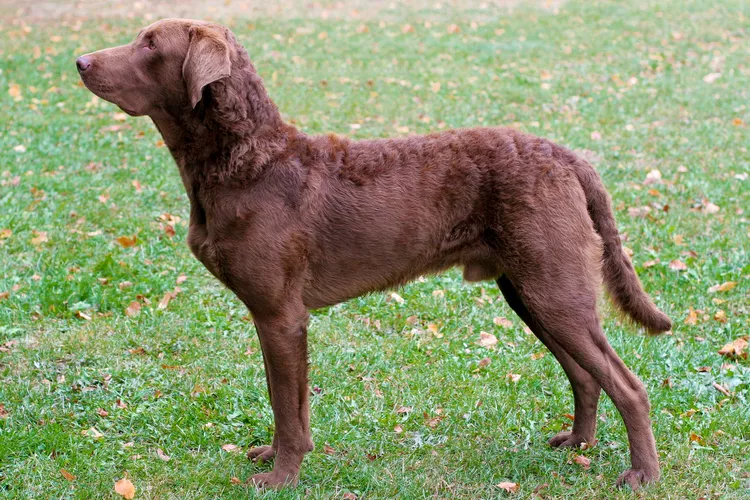
The Chesapeake Bay Retriever stands out for its impressive physique and strength, which suit its job as a hardworking and efficient sporting dog. This breed’s features include:
- Males are generally larger than females, giving them a formidable appearance and the ability to perform well outdoors.
- Their muscular build enables them to work hard and move swiftly through water.
- They possess athletic qualities that ensure they are well-balanced and proportioned, crucial for lasting long periods of activity and adapting to different landscapes.
The physical qualities of the Chesapeake Bay Retriever are linked to its past as a skilled retriever on both land and water.
Typical Size Range
Chesapeake Bay Retrievers fall into the medium to large dog breed category, with a body built for strength and endurance. Male Chesapeake Bay Retrievers typically stand between 23 and 26 inches tall and weigh between 65 and 80 pounds. Female dogs are usually smaller, standing 21-24 inches and weighing 55-70 pounds.
These dogs are not only muscular but also well-proportioned, which helps them perform well in outdoor activities and tasks that require retrieving. Their size and muscular build are ideal for their job as retrievers, especially in waterfowl hunting, where power and agility are necessary.
Muscular Body Frame
Chesapeake Bay Retrievers are known for their muscular bodies. They are built to perform challenging jobs like retrieving waterfowl. A male Chesapeake Bay Retriever stands between 23 and 26 inches tall, while a female measures 21 to 24 inches. Their weight supports their stature, ranging from 65 to 80 pounds for males and 55 to 70 pounds for females. Their physical strength and endurance make them excellent at swimming and hiking.
Chesapeake Bay Retrievers need regular exercise and activities that challenge their minds to keep their muscles in shape. If they don’t get this, they might lose their physical condition and develop behavior problems from lack of stimulation. That’s why it’s essential to stick to a routine with physical workouts to support their health and happiness.
Athletic Physical Traits
Chesapeake Bay Retrievers have a solid muscular build suited for an active lifestyle. They stand between 21 and 26 inches tall and weigh 55 to 80 pounds. This size places them in the medium to large dog category, where they possess considerable strength and endurance. These dogs need regular exercise to maintain their health due to their physical attributes designed for agility and stamina.
The Chesapeake’s body structure, with higher hindquarters than their shoulders, gives them a robust appearance. Their double coat is perfect for cold climates, featuring a rugged, waterproof outer layer and a warm, thick undercoat. This combination prepares them to perform efficiently in cold, challenging conditions, a nod to their past as skilled retrievers.
Weight and Height
Chesapeake Bay Retrievers are known for their solid build and impressive stature. Male dogs typically have a height of 23 to 26 inches, while females measure between 21 and 24 inches—their size points to their historical role in physically demanding tasks such as retrieving. Male Chesapeake Bay Retrievers weigh about 65 to 80 pounds, with females slightly lighter at 55 to 70 pounds. Their muscular frame places them in the medium to large category for dog breeds.
Their physical attributes are well-suited to their job as waterfowl retrievers. A Chesapeake Bay Retriever’s weight and height contribute to a balanced body that supports their work. These dogs are designed for active roles that require endurance and physical strength. Their body structure allows them to move with agility and last through long periods of activity, which is why they excel in dog sports and outdoor adventures.
Balance and Proportion
Considering the Chessie or Chesapeake Bay Retriever’s size, it’s evident that their physical attributes are crucial for both their appearance and their functionality. The standard size for male Retrievers is between 23 and 26 inches tall and weighs between 65 and 80 pounds. The female Retrievers should stand at 21-24 inches and weigh between 55-70 pounds. This size ensures they are powerful and agile, necessary for a dog bred for retrieving waterfowl.
The right proportions are essential for this breed’s work ethic and versatility. A well-built body that combines strength and skill is necessary for a dog specializing in waterfowl retrieval. Good training takes advantage of their strength and stamina, improving their ability to work effectively.
Their muscular chests and powerful hindquarters are proof of their ability to handle challenging environments and intense activity, which is essential for their role as reliable and versatile working dogs.
Character Disposition
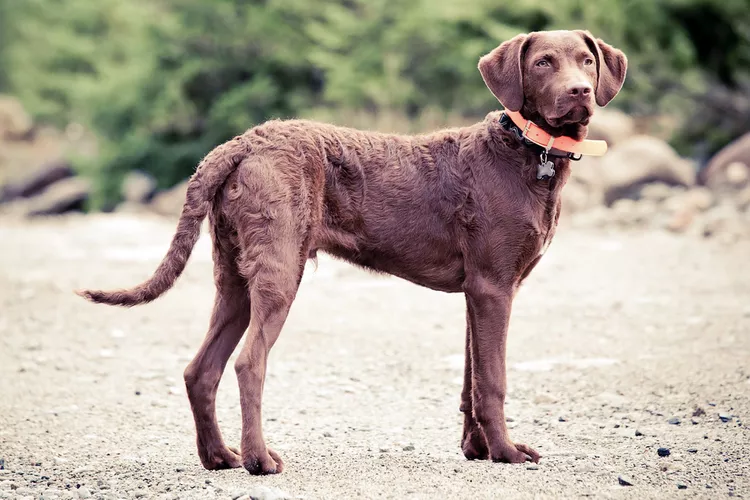
When learning about the Chesapeake Bay Retriever, it’s essential to consider these critical factors:
- Breed Personality: These dogs range from being confident to friendly. Understanding the unique personality of each dog in this breed is vital.
- Social Skills: It’s vital to start socializing these dogs early and keep it consistent. This helps them get comfortable with people and other animals.
- Hunting Instincts: Chesapeake Bay Retrievers have an instinct to chase. Owners need to manage this instinct to avoid any issues with their behavior.
These factors are important because they affect how well these dogs fit into home settings and behave around other animals and people.
Breed Temperament Traits
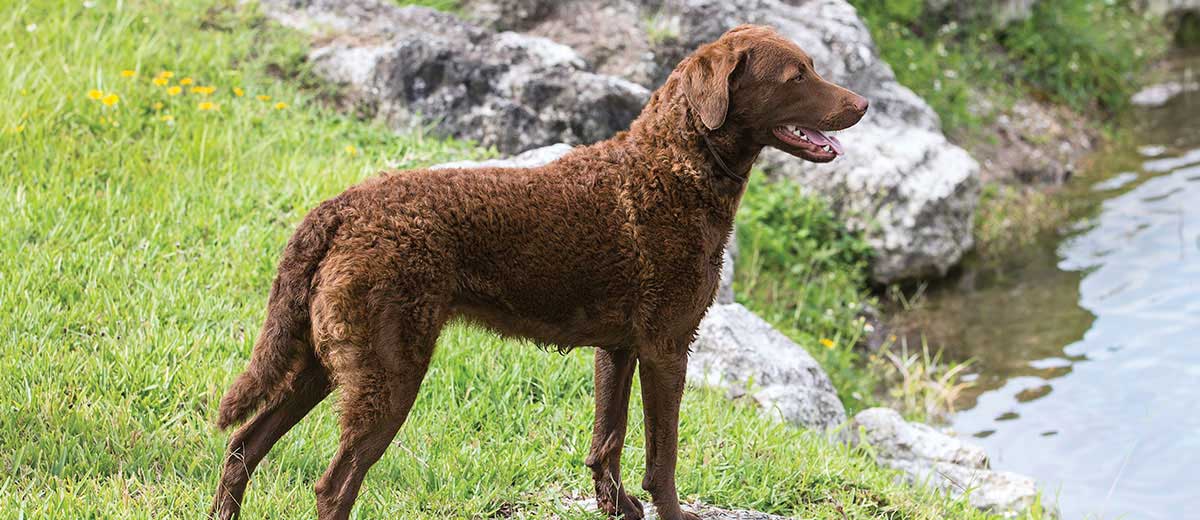
Chesapeake Bay Retrievers have a range of personalities, from bold and quiet to friendly and easy-going. It’s crucial to start socialization early so they can fit well into their new homes.
These dogs are cherished as family pets for their lively and cheerful nature. With steady daily training, they become intelligent and loving companions.
Sometimes, they can be pretty stubborn, which is part of their determined character from their history. This means their handlers must be firm and patient to guide their strong personalities in the right direction.
These retrievers are usually very warm with their own families but can be cautious around new people, showing why getting them used to different social situations is crucial.
Socialization Requirements
To help a Chesapeake Bay Retriever grow up confident and friendly, starting socializing them early on is vital. This breed must meet many different people and animals and get used to various places during training. During their crucial growth periods, they should only have positive experiences to prevent them from becoming shy or aggressive later.
Taking them to obedience classes and arranging playdates with other puppies are great ways to support their mental and emotional development. Getting them involved in dog sports and different outdoor activities and exposing them to new social situations is critical to helping them learn to adapt and thrive, which is good for their overall health.
Prey Drive Management
Training Chesapeake Bay Retrievers to manage their hunting instincts is crucial. From an early age, it’s essential to channel their desire to chase through socialization and positive reinforcement. This helps curb the unwanted chasing of small animals.
Training should be regular and focus on positive methods to redirect their instincts into activities like retriever games or specific exercises. These keep their minds sharp and ensure they get enough physical activity.
Allowing controlled playtime with smaller animals can teach them to be gentle. Understanding and respecting their natural behaviors is critical to maintaining a well-behaved dog.
Interaction With Children
Knowing how they act around kids is essential when looking into getting a Chesapeake Bay Retriever for your family. These dogs are loving and want to protect, but they need firm rules and to meet lots of different people early on to avoid problems. Chesapeake Bay Retrievers usually like kids, but they won’t put up with being mistreated. Teaching your kids how to play nicely with the dog is critical to prevent rough behavior.
Since these dogs naturally want to guard their family, they might not understand kids just playing around and could get too rough themselves. Always keep an eye on them when they’re together. Chesapeake can also be selfish with its toys and food, which might not be great around tiny children unless you’re on top of it.
To ensure everyone gets along, teach your kids to give the dog space and ensure it knows how to be around people.
Behavior With Other Pets
Understanding how Chesapeake Bay Retrievers interact with other pets is crucial, mainly since their socialization as puppies significantly affects their future relationships with other animals. When they meet new pets correctly, these dogs can be friendly with other dogs and different kinds of household pets. However, they can sometimes react defensively to dogs they don’t know because of their instinct to guard their territory. Male retrievers might show signs of dominance or even aggression, which shows how important it is to train them well.
Chesapeake Bay Retrievers are known for their calm nature and don’t bark excessively, which can help them get along with other animals at home if someone is always watching them. They are protective and loyal, which makes them good watchdogs, but they usually don’t act aggressively toward people they don’t know. It is vital to teach them how to socialize early on so they can live peacefully with pets of other species.
Vitality and Wellness Concerns
The Chesapeake Bay Retriever is prone to specific health issues that owners should watch out for to maintain the dog’s well-being.
Proactive health screenings for conditions like hip dysplasia are vital to catch and treat problems early. Keeping the breed healthy involves regular vet visits and a wellness plan that suits their needs.
Sticking to a consistent health check routine helps prevent or manage inherited diseases and those that can develop over time.
Common Chesapeake Bay Retriever Health Issues
Chesapeake Bay Retrievers are hardy dogs but prone to some genetic conditions. Hip dysplasia and cataracts are common, so keeping up with health screenings and vet visits is crucial. They can also experience exercise-induced collapse and progressive retinal atrophy, which can impact their well-being.
Occasionally, they may have Type 3 von Willebrand disease, affecting blood clotting and regional alopecia, impacting their coat. These Retrievers live around 10.75 years in the UK and slightly less in the US, at 9.4 years, making regular vet check-ups vital.
Responsible breeding can help prevent these health issues; early treatment is critical when problems are noticed.
Lifespan Expectations
Chesapeake Bay Retrievers can live 10 to 13 years if they receive proper care and regular health check-ups. They’re at risk for specific genetic issues like hip dysplasia and progressive retinal atrophy. Being proactive with their health is essential, including frequent veterinary visits with a breed specialist.
To keep these dogs healthy, they need a diet that meets their nutritional requirements, proper coat care, and enough exercise and mental challenges. Good breeding practices can reduce genetic health problems and improve the breed’s health.
Wellness Check Schedule
Wellness Check Schedule for Chesapeake Bay Retriever
Regular health checks with a good vet are vital to keeping a Chesapeake Bay Retriever healthy and full of life. The vet should check the heart and joints during these visits to catch breed-specific issues early. Managing the dog’s weight is critical to avoid problems caused by being overweight.
It’s also vital to check their teeth to prevent gum disease, which can affect their overall health. Keeping up with flea and tick prevention and vaccinations is necessary to protect against disease.
A tailored diet and exercise plan is best for maintaining the dog’s health and helping it live long.
Maintenance Essentials
A well-organized care plan is vital to keep a Chesapeake Bay Retriever healthy and happy. This includes attention to their unique needs and overall health. Here are the essentials:
- Grooming: Regular brushing is necessary to control shedding and keep the dog’s skin in good condition.
- Exercise: These dogs need plenty of physical activity to stay fit and keep their minds sharp.
- Health: Stay ahead of any potential breed-specific health issues with regular vet check-ups and preventative care.
These basics are the groundwork for a thorough discussion on how to best care for this strong breed.
Grooming Needs
Regular brushing is vital to maintaining the health and appearance of the Chesapeake Bay Retriever. This breed has a unique double coat that needs attention to prevent tangles and skin issues. A thorough brushing should be done weekly. Their fur is waterproof and has a thick underlayer that can mat if neglected.
Bathe your dog every few months and ensure they are scorched afterward to avoid skin problems. Although the breed has a natural musky smell, which suggests they don’t need much grooming, cleanliness is still essential for their health.
Regular checks of the ears are essential to prevent infections, and keeping up with teeth cleaning and nail trimming is vital for their overall well-being.
When shedding increases, a professional groomer might sometimes need to keep their coat in good shape and ensure proper hygiene.
Exercise Requirements
Chesapeake Bay Retrievers have specific needs when it comes to staying active. They should get between 20 to 40 minutes of exercise every day. This routine is vital to keep them healthy and to fulfill their instincts. If these energetic dogs don’t get enough physical activity, they might start showing unwanted behaviors. These can arise from not having their mental and physical needs met.
To keep a Chesapeake Bay Retriever in top shape, mix their workouts with long walks and include some swimming or hiking for variety. These activities help keep their muscles strong and their minds sharp.
It’s also essential to have regular obedience training sessions. This helps prevent any dominance issues by promoting good behavior. Giving them specific tasks during exercise can keep their minds busy and stop them from getting into mischief.
Health Considerations
Regular vet visits are vital for monitoring the health of Chesapeake Bay Retrievers, especially since they’re prone to hereditary conditions.
These energetic dogs need a lot of exercise and brain games to stay fit and dodge obesity, which worsens problems like hip dysplasia. Feeding them right is just as essential to avoid weight issues.
Their waterproof coat demands frequent brushes and the odd bath to keep it in top shape and cut down on shedding.
Various activities and steady training are crucial for their mental and emotional health.
Keeping up with these care basics is vital for a Chesapeake Bay Retriever’s well-being.
Nutritional Guidelines
Proper nutrition is vital to keeping a Chesapeake Bay Retriever in top shape. These dogs need a well-rounded diet that supports their energetic lifestyle and keeps their weight in check. Dog owners should pick out food that matches the dog’s age, how much they exercise, and their unique metabolic rate. It’s also essential to always have clean water for the dog to drink.
For the best health results, it’s a good idea to talk to a vet or a pet nutrition expert. They can help develop a feeding plan that’s just right for your dog’s needs. Along with the right food, Chesapeake Bay Retrievers should get plenty of exercise and things to do that keep their minds busy. This combination is vital for their overall well-being.
Training Strategies
When teaching a Chesapeake Bay Retriever, a well-thought-out plan that includes consistency and patience is vital. This breed tends to be headstrong and likes to make its own decisions. They’re not the easiest to teach, but daily obedience sessions are essential to deal with their natural tendency to resist following orders.
Mixing play with training keeps them interested and helps them learn.
Giving these dogs a task helps prevent unwanted behaviors such as chewing or biting. They need lots of exercise, like hiking and swimming, to keep them healthy and to fulfill their need to work.
Clear and confident leadership will gain the dog’s respect and show them where they fit in the family. Training should be strict but kind for the best outcome.
Nutritional Guidelines
To ensure your Chesapeake Bay Retriever stays healthy and energetic, it’s crucial to follow specific dietary guidelines. Here are the essential points to keep in mind:
- A well-rounded diet is critical to maintaining your dog’s health. Ensure that you include quality protein, healthy fats, and essential nutrients.
- Overfeeding can lead to weight issues, so measure food portions based on your dog’s age and activity level.
- Chesapeake Bay Retrievers can have joint issues, so include unique ingredients in their diet that support joint health.
Balanced Diet Essentials
A healthy diet is vital for Chesapeake Bay Retrievers to keep them energetic and support their muscle health. Their meals should consist of high-quality proteins, good fats, and carbs.
Nutrients like omega-3 fatty acids are crucial for a shiny coat and healthy skin, while glucosamine and chondroitin support joint health, especially since these dogs are prone to hip dysplasia.
Monitoring food portions is necessary to prevent obesity, considering each dog’s metabolism and activity level. Working with a vet helps tailor the diet to the dog’s age, size, and health.
Adding a range of vet-recommended fruits and veggies can offer more nutrients while removing toxic dog foods.
Portion Control Tips
Maintaining a healthy weight for Chesapeake Bay Retrievers involves more than just a balanced diet; it also requires careful portion management. Adjusting food amounts based on the dog’s size, age, and activity is essential.
A standard measuring cup helps keep portion sizes consistent, critical to avoiding weight gain. Sticking to a regular feeding schedule instead of allowing the dog to eat anytime helps control their calorie intake and prevents them from overheating.
Use interactive feeders or puzzle toys to slow their eating and engage their minds. Talk to a vet if you need a tailored approach to portion control. They can provide advice based on the specific nutritional needs of your Chesapeake Bay Retriever.
Special Dietary Considerations
Chesapeake Bay Retrievers need a diet specifically designed for their active lifestyle. This includes a good balance of proteins, fats, and carbohydrates. They also need nutrients that support their joints and help avoid health issues common to the breed.
Feeding them high-quality food with glucosamine and chondroitin is crucial for maintaining their strong bones and muscles and helping prevent hip dysplasia.
Feeding them regularly is vital to prevent bloat, a serious condition often seen in dogs with deep chests. Keeping an eye on how many calories they eat helps stop them from becoming overweight, which can put extra strain on their joints.
Regular consultations with a vet can help create a feeding plan that’s just right for a Chesapeake Bay Retriever’s health needs.
